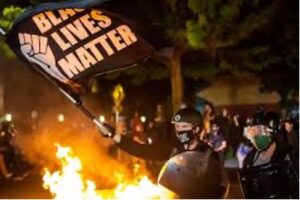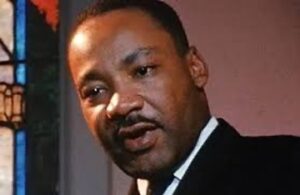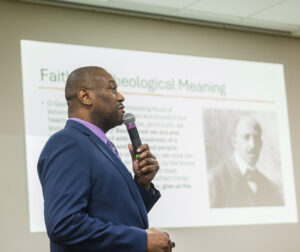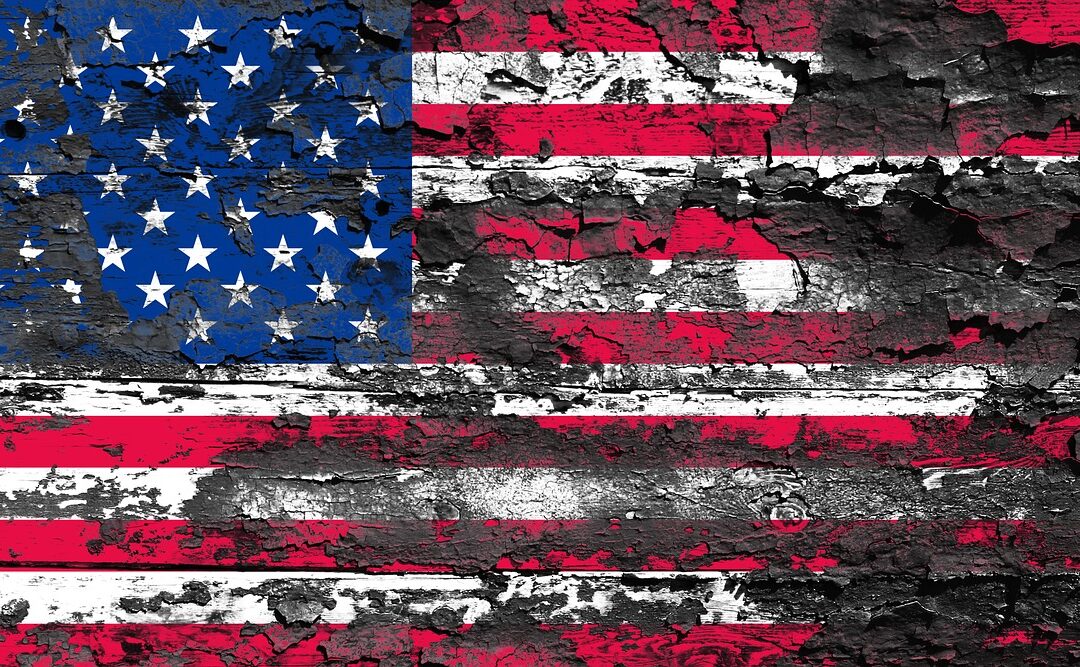By Dr. Lewis Brogdon
Executive Director of the Institute for Black Church Studies, BSK Theological Seminary
Introduction: The American Mirage
Nihilism is a term that originated in 19th-century Europe to describe the collapse of meaning, purpose, and moral authority in the wake of Christianity’s decline. At its core, nihilism — from the Latin nihil, meaning “nothing” — names the condition in which societies lose belief in shared truths and moral direction, when nothing seems to matter and no one can be trusted. Friedrich Nietzsche, one of its most forceful voices, warned that Europe stood on the precipice of a spiritual crisis — one that would unfold over centuries.
But Nietzsche could not have foreseen the peculiar form nihilism would take in the American context. In the United States, nihilism did not emerge from the collapse of Christianity alone, but from its grotesque distortion — a religion that sanctified slavery, rationalized genocide, and baptized white supremacy. American nihilism is racialized, institutionalized, and morally anesthetized. It is a crisis not just of belief, but of character — embedded in institutions, laws, and everyday life.
 Over the past decade, but especially since 2020, I have become increasingly convinced that the nation is experiencing a profound collapse — not just of political norms or social trust, but of meaning itself. In my earlier work, Hope on the Brink, I argued that nihilism had become a spiritual crisis in Black America, taking the form of internalized despair, self-hatred, and community disintegration. But today, it is a broader, more pervasive nihilism that is destabilizing the country. Manifesting in denial, apathy, violence, and the moral collapse of institutions, this deepening crisis has emerged as a driving force behind America’s unraveling.
Over the past decade, but especially since 2020, I have become increasingly convinced that the nation is experiencing a profound collapse — not just of political norms or social trust, but of meaning itself. In my earlier work, Hope on the Brink, I argued that nihilism had become a spiritual crisis in Black America, taking the form of internalized despair, self-hatred, and community disintegration. But today, it is a broader, more pervasive nihilism that is destabilizing the country. Manifesting in denial, apathy, violence, and the moral collapse of institutions, this deepening crisis has emerged as a driving force behind America’s unraveling.
Today, we are not merely witnessing political dysfunction or economic instability. We are watching the slow disintegration of a society that can no longer tell the truth about itself, a society where the myth of moral greatness is crumbling under the weight of its own contradictions. How can a nation that ranks first in incarceration, leads the world in gun deaths, and spends more on its military than the next nine countries combined still claim to be a beacon of freedom and hope? How can a country where billionaires flourish while 40 million people live in poverty continue to claim moral authority?
These are not simply policy failures — they are signs of a deeper crisis. A crisis of meaning. A collapse of moral imagination. This is what nihilism looks like in America: a society rich in resources and poor in soul, where empathy dies quietly, and injustice is normalized through repetition. This article explores the shape and consequences of nihilism in American life. Drawing from philosophical, theological, and historical insights, I argue that white supremacy, systemic injustice, and moral hypocrisy have hollowed out the nation’s institutions. As a result, America now stands where other empires have stood — on the edge of decline, facing a reckoning it cannot name.
- The Illusion of Greatness: America’s Global Rankings
Empires rarely collapse in a single moment; they erode from within. Often, the signs are measurable before they are admitted. The United States is no exception. It remains one of the wealthiest nations in the world, yet its internal metrics betray a crisis of staggering proportions — a crisis that nihilism helps to obscure rather than resolve.
Consider the data. As of 2024, the United States ranked 11th in COVID-19 deaths per 100,000 people, despite having the medical resources to lead the world in pandemic response. It ranks second in gun-related deaths and first in incarceration rates, locking up a greater percentage of its population than any other democracy on earth. The U.S. also leads the world in military spending — outpacing the next nine countries combined — while placing 37th in healthcare outcomes and 20th in education quality.
In terms of democracy, the numbers are no less sobering. Voter turnout in the 2020 presidential election reached 62.8% — a high point in recent U.S. history — yet still placed the nation 31st out of 50 democracies in terms of voter participation. National pride has dropped to record lows, with only 49% of white Americans saying they are “extremely proud” to be American — and less than half that number among non-whites.
These are not just failures in policy. They are indicators of a deeper decay. A nation that continually congratulates itself on being exceptional, while exhibiting characteristics of decline, is suffering from delusion. The gap between the mythology of American greatness and the lived reality of its people — especially its poor, its Black and brown citizens, and its disillusioned youth — is a breeding ground for nihilism. When people no longer believe that the system can deliver justice, opportunity, or even coherence, the entire social order teeters.
The Great Divide: Class and the Mirage of Meritocracy
In his book Dream Hoarders, Richard Reeves argues that it’s not just the ultra-wealthy who rig the system — the top 20% of earners in the U.S. use exclusive zoning, legacy admissions, unpaid internships, and tax shelters to pass down advantage to their children, often under the banner of meritocracy. He calls this behavior opportunity hoarding — the quiet, everyday ways the upper middle class preserves its status while appearing morally neutral.1 But opportunity hoarding is not only a class issue. As sociologist Nancy DiTamaso reveals in The American Non-Dilemma, it is also deeply racial. DiTamaso shows that many white Americans benefit from racial advantage not through overt racism, but through routine acts of favoritism within segregated social networks — exchanging favors, jobs, or information in ways that quietly exclude others.2
While Reeves challenges the myth of meritocracy, DiTamaso challenges the myth of non-racism. Together, their work reveals how inequality is maintained not just by bad actors, but by well-meaning people acting in self-interest within homogenous, privileged circles. In both accounts, inequality is not just accidental — it is actively reproduced. The comfort of the privileged depends on the invisibility of these mechanisms, and on a society that frames inequality as an individual failure rather than a systemic reality.
Following the work of Reeves and DiTamaso, we can see how the preservation of privilege isn’t accidental — it is the result of a deeply stratified system that rewards insularity. Between 1979 and 2013, the top fifth of U.S. households gained $4 trillion in pre-tax income — more than the combined gains of the bottom 80%.3 This is not simply the result of talent or innovation. It reflects a rigged system designed to protect class advantage. Reeves writes, “It is not just the top 1 percent pulling away, but the top 20 percent… The gap between the top fifth and the 80 percent below them is the Great Divide in both the American economy and in American society.”4 This class entrenchment feeds the despair of those locked out and reinforces the illusion among elites that they are morally deserving of their status. It fractures any sense of shared fate — another deep fracture in the American moral order.
America’s national story is filled with triumphal milestones — the founding colonies in 1607, the Revolutionary War, the Declaration of Independence, the Civil War, two World Wars, the Civil Rights Movement, the moon landing, and the election of Barack Obama in 2008. These moments are stitched into a narrative of exceptionalism: the colony that became the most powerful empire in history, capable of overcoming national tragedies and international threats. But alongside this myth of progress lies a deeper truth: the great contradiction of a country founded on liberty that has enslaved, exploited, and marginalized millions. It is a land of selective opportunity — a place of dreams for some and nightmares for others. Even religion has not been spared, often valued and distorted to serve power rather than justice. This duality is not incidental. It is America’s original wound — and its unresolved shadow.
And yet many Americans, particularly white Americans, continue to fight to sustain these failing systems. This is not simply political conservatism — it is moral inertia. It is white nihilism disguised as patriotism. It is a refusal to interrogate the moral bankruptcy of institutions built on stolen land, enslaved labor, and racial hierarchy. As Dr. King warned, a nation that does not share its blessings will be forced to face the fury of those it has locked out.
III. White Nihilism: The Moral Vacuum
Nihilism is not merely the loss of meaning in a general sense; it is the unraveling of a racialized moral order that once gave white Americans a sense of legitimacy, superiority, and historical destiny. For centuries, whiteness in America was not just a racial category — it was a framework of moral entitlement, rooted in Christianity, exceptionalism, and racial hierarchy. As those foundations are now exposed as morally bankrupt, many white Americans are experiencing a profound disorientation — a loss not just of privilege, but of purpose.
This is the distinct form of nihilism now destabilizing the country. It is white nihilism: the moral collapse that emerges when whiteness can no longer function as a stable source of identity or moral coherence. In this vacuum, we see the rise of denialism, grievance politics, violent extremism, and an aching nostalgia for a past that never truly existed — but which felt secure to those it privileged.
White nihilism manifests in the refusal to take Black and brown suffering seriously, in the defense of institutions that harm the vulnerable, and in policies that prioritize white comfort over multiracial justice. It enables one to champion “family values” while ignoring children in cages; to speak of “law and order” while excusing state violence; to claim moral high ground while protecting systems that deny others dignity. This is more than hypocrisy — it is the breakdown of ethical coherence. It is what happens when a people can no longer distinguish righteousness from dominance.
Historically, white morality was inseparable from power. But as that order is challenged by demographic change, prophetic resistance, and cultural upheaval, it responds not with repentance, but with retrenchment. The backlash to Barack Obama’s presidency, the rise of Trumpism, and the mainstreaming of white nationalist ideologies are not political anomalies — they are expressions of white nihilism. They are frantic attempts to recover a fading moral centrality in a world moving beyond whiteness.
What emerges is not a revitalized moral vision but a spiritual vacuum filled with anger, entitlement, and fantasy. This is why QAnon, Christian nationalism, and “Make America Great Again” function less as ideologies and more as coping mechanisms for white decline. They do not offer real solutions. They offer meaning without truth, identity without accountability, and belonging without justice.
Cornel West once described nihilism as a “monumental eclipse of hope.” In white America, that eclipse is nearly total. Many white Americans no longer believe in the future of their country — at least not a future that includes equality, accountability, or sacrifice. Instead, they cling to myths, retreat into isolation, or lash out in violence. This is not simply political dysfunction — it is moral erosion. It is what happens when a people, accustomed to domination, lose faith in the very institutions they once controlled.
- Black Protest as a Response to White Nihilism
If white nihilism reveals a moral collapse, then Black protest represents a desperate effort to reclaim meaning, dignity, and humanity in a society that constantly denies them. For centuries, Black Americans have lived with the contradiction of a nation that proclaims liberty while enforcing racial terror. In the face of this hypocrisy, Black resistance has always been more than political — it has been existential.
 The protest movements of 2020 were not simply responses to the murder of George Floyd or Breonna Taylor. They were eruptions of accumulated grief, rage, and moral clarity — a collective outcry against the machinery of white nihilism. What many white Americans perceived as disruption or disorder was, in fact, a prophetic demand: that the nation acknowledge its failure to be just, and that it account for the lives it continues to treat as disposable.
The protest movements of 2020 were not simply responses to the murder of George Floyd or Breonna Taylor. They were eruptions of accumulated grief, rage, and moral clarity — a collective outcry against the machinery of white nihilism. What many white Americans perceived as disruption or disorder was, in fact, a prophetic demand: that the nation acknowledge its failure to be just, and that it account for the lives it continues to treat as disposable.
But even in protest, Black voices are too often misread. White nihilism resists comprehension of experiences rooted in non-whiteness. It cannot process Black suffering as legitimate, nor Black rage as rational. Instead, it recoils. It pathologizes protest, emphasizes property damage, and sidesteps the root causes. In doing so, it reveals its moral incapacity.
This refusal to understand is not mere ignorance — it is what pastor and HBCU president Dr. Kevin Cosby describes as moral ignorance: a willful, stubborn refusal to acknowledge the truth, even when it is plainly evident. The Bible calls this condition a reprobate mind — the hardened state of those who no longer recognize or respond to moral reality. This reprobation functions like a spiritual cataract over the conscience of white America. It explains why injustice can be so visible, yet remain uncorrected. Why the cries of the oppressed can be so loud, yet fall on deaf ears.
This is why some Black voices, particularly among radical and non-religious communities, have abandoned appeals to white moral decency altogether. They no longer believe white institutions have the capacity to do right by Black and brown people. Instead, they turn to power, confrontation, even chaos. They believe order must be broken before justice can be born. These are not mere outbursts — they are tactical responses to moral inertia.
Meanwhile, many mainstream Black leaders remain committed to working within the system, believing reform is still possible. But increasingly, even those voices are beginning to question the efficacy of that path. The disillusionment is spreading. The moral appeals that once inspired progress now echo in a hollow public square, where too many are unmoved. The high road feels like a dead end.
- The Path Forward: Confronting Nihilism
Nihilism is not inherently destructive. It is a condition — a crisis — that can turn in multiple directions. It can rot a society from the inside, or it can serve as a moment of moral reckoning. The question facing America today is not whether nihilism is real, but whether it can be redirected toward transformation rather than collapse.
To confront white nihilism is to demand that white Americans ask themselves difficult questions: What do we actually believe? What moral vision do we live by? Can we still build a society where justice, equity, and love are possible — not just rhetorically, but structurally? These are not academic questions. They are questions of national survival.
This unraveling is not simply about race or politics. It’s also about class. America suffers from what scholars now describe as elite overproduction — a surplus of educated, credentialed individuals vying for diminishing opportunity and social mobility. Coupled with institutional decay and widespread poverty, this has created a combustible environment of frustration, resentment, and moral confusion. These conditions — demographic shifts, widespread contempt, institutional failure, and criminal justice collapse — are not abstract trends. They are warning signs of a republic in spiritual freefall.
The path forward requires more than reform. It demands a reconstruction of meaning. This reconstruction must begin with truth-telling — about race, history, faith, power, and the economic structures that continue to exploit and divide. It must involve an honest assessment of the spiritual sickness that has gripped white America: a nihilism so pervasive that it justifies violence while calling itself “order,” and protects lies while calling itself “tradition.”
But there is also opportunity. Crises often precede clarity. Out of this moment could emerge a new coalition — a multiracial, multifaith movement grounded not in nostalgia or dominance, but in humility, truth, and collective liberation. It is possible. But only if the grip of white nihilism is broken. Only if the moral silence is shattered. Only if the systems we’ve inherited are no longer worshiped as gods.
The American empire is not invincible. Its fall is not inevitable — but it is imaginable. And the seeds of collapse are not just economic or political — they are moral and spiritual. If this nation cannot rediscover its soul, then it will lose its story. And with it, its future.
- The War Within: Social Conflict as a Symptom of Nihilism
 Dr. Martin Luther King Jr., in a searing 1967 NBC News interview, confessed that his dream had become a nightmare. Disillusioned by the escalating violence in Vietnam and deepening racial tensions at home, King warned of what happens to a society that becomes obsessed with war. He identified five moral consequences: it loses its social perspective, makes people insensitive, dulls the conscience, strengthens the forces of reaction, and fosters bitterness, hatred, and violence.
Dr. Martin Luther King Jr., in a searing 1967 NBC News interview, confessed that his dream had become a nightmare. Disillusioned by the escalating violence in Vietnam and deepening racial tensions at home, King warned of what happens to a society that becomes obsessed with war. He identified five moral consequences: it loses its social perspective, makes people insensitive, dulls the conscience, strengthens the forces of reaction, and fosters bitterness, hatred, and violence.
These warnings were prophetic — not only about America’s military adventurism abroad, but about a deeper spiritual decay at home. Dr. King saw how a society obsessed with the guns of war would inevitably suffer moral consequences: it would lose its social perspective, become desensitized, dull the conscience, strengthen the forces of reaction, and bring forth bitterness and violence. That prophecy has come full circle.
Today, America is no longer just at war abroad — it is at war with itself. The obsession with domination, once projected outward through imperial power, has now turned inward through cultural warfare, political extremism, and interpersonal distrust. The weapons have changed — from rifles to rhetoric, bombs to misinformation — but the consequences remain the same: numbed consciences, reactionary politics, hardened hearts, and deepening social violence.
Today’s America is gripped by an entrenched form of social chaos and conflict, marked by dysfunction, division, pride, and violence. These are not just symptoms of political tension — they are expressions of a nation suffering from moral and spiritual disintegration. And they are deeply entrenched, not incidental. They have become normalized.
- Dysfunction is evident in paralyzed governance, eroded institutions, and the breakdown of public trust.
- Division permeates every domain — race, class, religion, and ideology — fracturing a shared national identity.
- Pride, not the healthy kind, but the hubris that refuses self-examination, fuels denial and blocks moral transformation.
- Violence has become a language — a way to respond to disagreement, to express despair, or to assert control.
These elements are not just coexisting — they reinforce one another.5 Dysfunction deepens division; division breeds pride and resentment; pride resists change; and violence becomes the inevitable release of unresolved national tension. In this context, King’s lament—”my dream has become a nightmare” — rings with new relevance. The country has turned its capacity for destruction inward.
Social conflict in America today is not simply about policy differences. It is the outgrowth of a deeper nihilism — a moral vacuum that can no longer distinguish between debate and dehumanization. When white grievance becomes gospel, when political opponents are cast as enemies, when institutions can no longer mediate common purpose, what remains is a society consumed by its own fragmentation. King’s lament is not just historical reflection — it is diagnosis. We are living in the nightmare he foresaw. The country’s inability to uplift the poor, its obsession with power, and its moral numbness in the face of inequality are not policy choices — they are spiritual failures. The bitterness and violence erupting in our streets and legislatures are not random — they are the symptoms of a nihilistic nation that has turned its instruments of war inward.
Nihilism, then, is not just despair in abstraction. It is embedded in how a society treats its most vulnerable, how it uses power, and how it copes with difference. A society that cannot imagine a future together will inevitably become a battlefield of competing fantasies. The truth is: America is not just declining — it is devouring itself.
VII. Conclusion: A Call to Moral Awakening
The United States is standing on a precipice — not merely of political unrest or economic fragility, but of existential collapse. The crisis we face is deeper than polarization or partisan division. It is a moral and spiritual collapse, one whose roots are buried in centuries of white supremacy, historical denial, and institutional hypocrisy. This is what nihilism looks like when it becomes national: not chaos alone, but the cold, hollow maintenance of order without meaning, structure without substance, morality without mercy.
White nihilism — this moral vacancy in the heart of the American project — has twisted faith into nationalism, patriotism into idolatry, and democracy into performance. It resists correction because it denies wrongdoing. It resists justice because it refuses to see its victims as fully human. And it resists hope because, deep down, it no longer believes in a future worth sharing.
But nihilism is not destiny. It is a mirror. It shows us who we are when our illusions fail. And it gives us a choice. We can follow the path of past empires, ignoring warning signs until collapse becomes irreversible. Or we can embrace the rupture as revelation — a chance to rebuild. To begin again not with domination, but humility. Not with myths of greatness, but with a commitment to justice grounded in truth.
This article has traced the many indicators of America’s decline — from global health rankings to incarceration, from voter disengagement to wealth inequality. The data is unambiguous:
- The U.S. ranked 11th in COVID-19 deaths per 100,000 people as of 2024, with over 1.1 million lives lost due to a fragmented and politicized response.6
- It remains first among developed nations in incarceration, with more than 2 million people imprisoned.7
- It leads in gun deaths among high-income countries.8
- It ranks 37th in healthcare and 20th in education, despite outspending nearly every nation.9
- In the 2020 election, its voter turnout was 62.8%—31st globally, behind countries like Colombia and Greece.10
- In the UN’s Human Development Index, the U.S. sits at #13, behind nations like Norway, Switzerland, and Germany.11
None of these figures exist in isolation. They are symptoms of a deeper pathology — a fraying social fabric held together by denial, fear, and fantasy. If we do not confront the moral bankruptcy underlying these statistics, we will remain locked in cycles of unrest, despair, and eventual decline. The burden of this moment falls not just on political leaders, but on all who see. All who still believe that love, justice, and truth can shape public life. All who know that a society that ignores suffering cannot call itself moral, and that a faith that blesses inequality is not divine.
Martin Luther King Jr. once warned that “without a spiritual and moral reawakening, we shall destroy ourselves in the misuse of our own instruments.”12 That time of reckoning has come. The American empire may not fall tomorrow — but it is already falling inward. This collapse is not merely structural — it is spiritual and personal. It implicates not just systems, but people. As psychologist Philip Zimbardo argues in The Lucifer Effect, the boundary between good and evil is not fixed, but permeable. Ordinary individuals, under certain systemic and situational pressures, are capable of participating in or enabling harm.13 It is not always hatred or ideology that drives moral failure — sometimes it is obedience, convenience, fear, or silence. Nihilism metastasizes precisely because most people do nothing while systems corrode and cruelty becomes normalized.
This is the deeper danger of American nihilism: not simply national decline, but the quiet erosion of individual conscience. The collapse begins when good people — or those who think themselves good — look away, justify harm, or retreat into private comfort. Zimbardo’s research shows that it is not monstrous individuals, but compromised institutions and manipulated environments, that often make evil possible. The question, then, is no longer abstract. It is deeply personal: How might I be contributing to the failure? What am I willing to see, to risk, to change? Nihilism is not destiny. It is a warning. It tells us that the moral order is collapsing — and asks what we are prepared to do about it.
The only question now is whether we will awaken before the collapse is complete.
Notes
- Richard Reeves, Dream Hoarders: How the American Upper Middle Class Is Leaving Everyone Else in the Dust, (Washington, D.C.: Brookings Institution Press, 2017).
- Nancy DiTomaso, The American Non-Dilemma: Racial Inequality Without Racism (New York: Russell Sage Foundation, 2013).
- , 6.
- , 20.
- Lewis Brogdon, America: An Empire in Decline (PowerPoint lecture, 2022).
- The Guardian, “American Health System Ranks Last Among Wealthy Countries,” September 2024, https://www.theguardian.com/us-news/2024/sep/18/american-health-system-ranks-last.
- Prison Policy Initiative, “Mass Incarceration: The Whole Pie 2024,” https://www.prisonpolicy.org/reports/pie2024.html.
- The Commonwealth Fund, “Gun Violence in the U.S. Compared to Other Countries,” October 2024, https://www.commonwealthfund.org/publications/2024/oct/comparing-deaths-gun-violence-us-other-countries.
- Peter G. Peterson Foundation, “U.S. Healthcare and Education Rankings,” 2023–2024, https://www.pgpf.org.
- S. Census Bureau, “Voting and Registration in the Election of November 2020,” https://www.census.gov/newsroom/press-releases/2025/2024-presidential-election-voting-registration-tables.html.
- United Nations Development Programme, Human Development Report 2019, http://hdr.undp.org/en/content/2019-human-development-index-ranking.
- Martin Luther King Jr., Where Do We Go from Here: Chaos or Community? (Boston: Beacon Press, 1967), 172.
- Philip Zimbardo, The Lucifer Effect: Understanding How Good People Turn Evil (New York: Random House, 2007), 3–24.
About the Author

Lewis Brogdon (Ph.D.) serves as the Executive Director of the Institute for Black Church Studies and Associate Professor of New Testament and Black Church Studies at BSK Theological Seminary in Lexington and Louisville, Kentucky. An accomplished scholar and writer, Brogdon is the author of several books, including The Gospel Beyond the Grave (Cascade, 2025), The Bible in the Ashes of Social Chaos (Cascade, 2023), A Companion to Philemon (Cascade, 2018), The Spirituality of Black Preaching (Seymour Press, 2016), The New Pentecostal Message? (Cascade, 2015), Dying to Lead: The Disturbing Trend of Clergy Suicide (Seymour Press, 2015), Hope on the Brink (Cascade, 2013), and No Longer a Slave but a Brother (Scholars Press, 2013).
Author’s Note
The author used OpenAI’s ChatGPT to support the editorial process, including revising for clarity and style.

